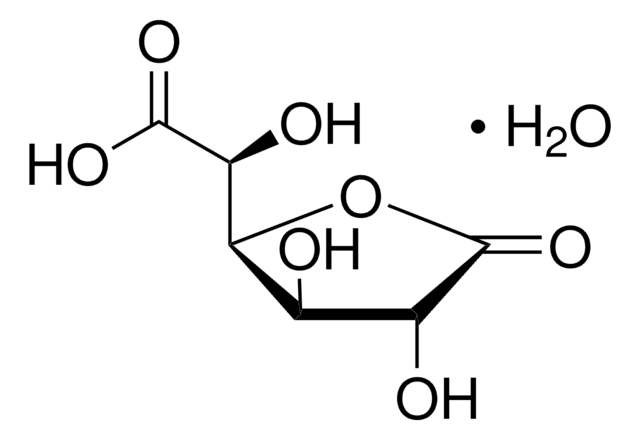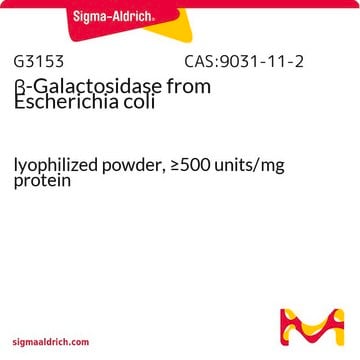I6034
α-L-Iduronidase human
recombinant, expressed in mouse NSO cells
Synonym(s):
IDUA
Sign Into View Organizational & Contract Pricing
All Photos(1)
About This Item
Recommended Products
recombinant
expressed in mouse NSO cells
Quality Level
form
solution
specific activity
≥7,500 units/μg protein
mol wt
83 kDa
impurities
≤1.0 EU/μg Endotoxin
shipped in
wet ice
storage temp.
−20°C
General description
α-L-Iduronidase (IDUA) is mapped to human chromosome 4p16.3. The mature IDUA protein is glycosylated and comprises triosephosphate isomerase (TIM) barrel domain, β-sandwich, helix-loop-helix region and an immunoglobin-like domain. α-L-Iduronidase is classified under glycoside hydrolase (GH) family 39.
Application
α-L-Iduronidase may be used for leukocyte assay in the study of a-L-Iduronidase deficiency in new born.
Biochem/physiol Actions
In lysosomal degradation process α-L-Iduronidase plays a crucial role. It hydrolyzes the non-reducing terminal α-L-iduronic acid residues in glycosaminoglycans (GAGs), including dermatan sulfate and heparan sulfate.
Mutation in the α-L-Iduronidase is implicated in Mucopolysaccharidosis I (MPS I) . This enzyme defect leades to accumulation of dermatan and heparan sulfate . MPS I pathophysiology is accompanied with deformation of the skull, mental retardation and hernias.
Catalyzes the hydrolysis of unsulfated α-L-iduronosidic linkages in dermatan sulfate
Physical properties
Expressed as C-terminal histine-tagged protein (residues 1-653) with a caluclated molecular mass of 71 kDa migrating at ~83 kDa under SDS-PAGE reducing conditions.
Unit Definition
One unit will produce 1 picomole of 4-methylumbelliferone from 4-methylumbelliferyl-α-L-iduronide per minute at pH 3.5 at 25 °C.
Physical form
Supplied as a solution in 40 mM sodium acetate , 400 mM NaCl and 20% (v/v) glycerol, pH 5.0
Storage Class Code
10 - Combustible liquids
WGK
WGK 1
Flash Point(F)
Not applicable
Flash Point(C)
Not applicable
Certificates of Analysis (COA)
Search for Certificates of Analysis (COA) by entering the products Lot/Batch Number. Lot and Batch Numbers can be found on a product’s label following the words ‘Lot’ or ‘Batch’.
Already Own This Product?
Find documentation for the products that you have recently purchased in the Document Library.
Customers Also Viewed
Vassili Valayannopoulos et al.
Rheumatology (Oxford, England), 50 Suppl 5, v49-v59 (2012-01-11)
Better understanding of disease pathophysiology, improved supportive care and availability of disease-specific treatments for some of the mucopolysaccharidosis (MPS) disorders have greatly improved the outlook for patients with MPS disorders. Optimal management of these multisystemic disorders involves a multidisciplinary team
Human kidney alpha-L-iduronidase: purification and characterization.
L H Rome et al.
Archives of biochemistry and biophysics, 189(2), 344-353 (1978-08-01)
Francesca Gatto et al.
Stem cells and development, 21(9), 1466-1477 (2012-01-28)
Mucopolysaccharidosis type I (MPS IH; Hurler syndrome) is a rare genetic disorder that is caused by mutations in the α-L-iduronidase (IDUA) gene, resulting in the deficiency of IDUA enzyme activity and intra-cellular accumulation of glycosaminoglycans. A characteristic skeletal phenotype is
Haiying Bie et al.
Nature chemical biology, 9(11), 739-745 (2013-09-17)
Mucopolysaccharidosis type I (MPS I), caused by mutations in the gene encoding α-L-iduronidase (IDUA), is one of approximately 70 genetic disorders collectively known as the lysosomal storage diseases. To gain insight into the basis for MPS I, we crystallized human
Patricia I Dickson et al.
Molecular genetics and metabolism, 106(1), 68-72 (2012-03-10)
Intrathecal enzyme replacement therapy is an experimental option to treat central nervous system disease due to lysosomal storage. Previous work shows that MPS I dogs receiving enzyme replacement with recombinant human alpha-l-iduronidase into the cisterna magna showed normal brain glycosaminoglycan
Our team of scientists has experience in all areas of research including Life Science, Material Science, Chemical Synthesis, Chromatography, Analytical and many others.
Contact Technical Service











